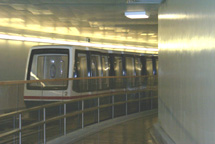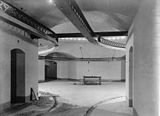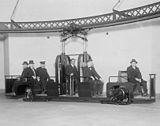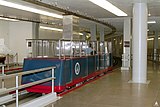|
United States Capitol subway system
The subway system of the United States Capitol Complex in Washington, D.C., consists of three underground electric people mover systems that connect the United States Capitol to several congressional office buildings – all of the Senate buildings and one of the House buildings. HistoryThe original subway line was built in 1909 to link the Russell Senate Office Building to the Capitol.[1] In 1960, an operator-controlled monorail was installed for the Dirksen Senate Office Building.[2] A two-car subway line connecting the Rayburn House Office Building to the Capitol was built in 1965.[3][4] The Dirksen monorail, which had been extended to the Hart Senate Office Building in 1982, was replaced in 1993 by an automatic train.[1][2] Network On the Senate side, two separate subway lines exist. The first is a crewed two-track system, with a single open-topped car operating on each track, connecting the Russell Senate Office Building and the Capitol. The other is a computer-controlled system with three enclosed trains of three cars each running on a 90-second schedule, connecting the Hart Senate Office Building, the Dirksen Senate Office Building, and the Capitol.[5] The train cars are unpowered; the train is propelled by a track-side linear motor. This line has two parallel tracks for most of its length, but at the Hart and Capitol stations the tracks converge into one, with a single side platform. This allows easy return travel on the opposite track. The Dirksen station features a side platform for Capitol-bound trains and an island platform for Hart-bound trains. All three of these stations feature platform screen doors. A small maintenance spur is located adjacent to the Hart station. On the House side, an older, crewed two-track system, with a single open-topped car operating on each track, shuttles passengers between the Rayburn House Office Building and the Capitol. The remaining four House office buildings are not serviced by the subway system; two (Cannon and Longworth) use a shared underground footpath tunnel while the other two (Ford and O'Neill) have no underground connection to the capitol. The House and Senate subway systems do not terminate in the same location under the Capitol, but they are connected by a labyrinth of tunnels. SecurityThe public can travel on the trains — usually during a tour of the Capitol Complex — but must be escorted by a staff member with proper identification. During votes, the House subway is restricted to congressional members. The Russell subway is restricted to members and staff during Senate votes. Since the terrorist attacks of September 11, 2001, restrictions have been placed on visitors using the Senate subway between the Hart and Dirksen buildings. 1947 shootingSenator John W. Bricker was shot at as he entered the Capitol subway tunnel by former Capitol Police officer William Louis Kaiser on July 12, 1947.[6] Bricker survived as the shots did not hit him. 2007 collisionA collision occurred on October 2, 2007, in the Rayburn to Capitol subway line after a car failed to slow down when it reached the end of the track line. The operator was injured and taken to a hospital for observation.[7] Image gallery
Rolling stockCurrent cars:[8]
Retired cars:
See alsoReferences
External linksWikimedia Commons has media related to United States Capitol Subway System.
|
||||||||||||||||||||||||||||||||||||||||||||||||||||||||||||||||||||||||||||||||













